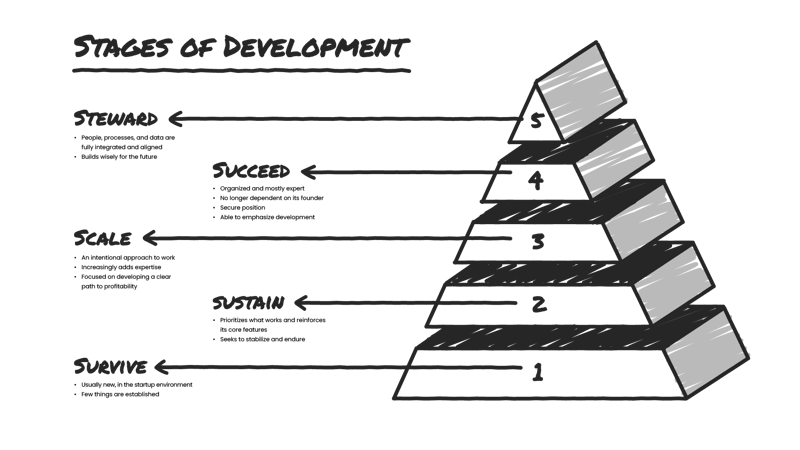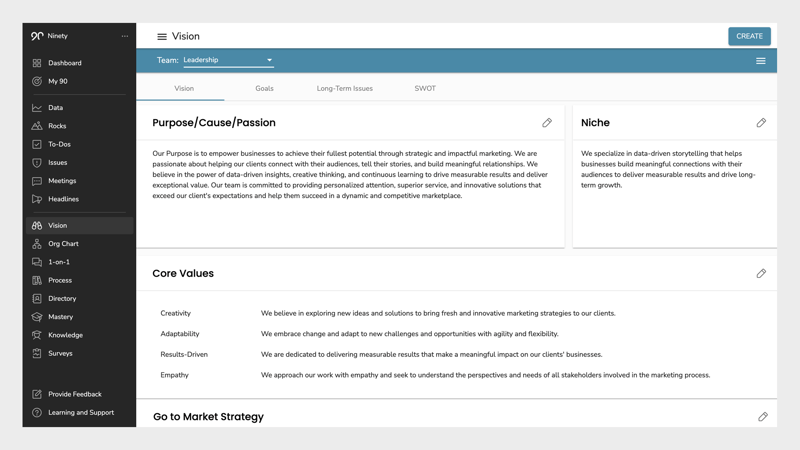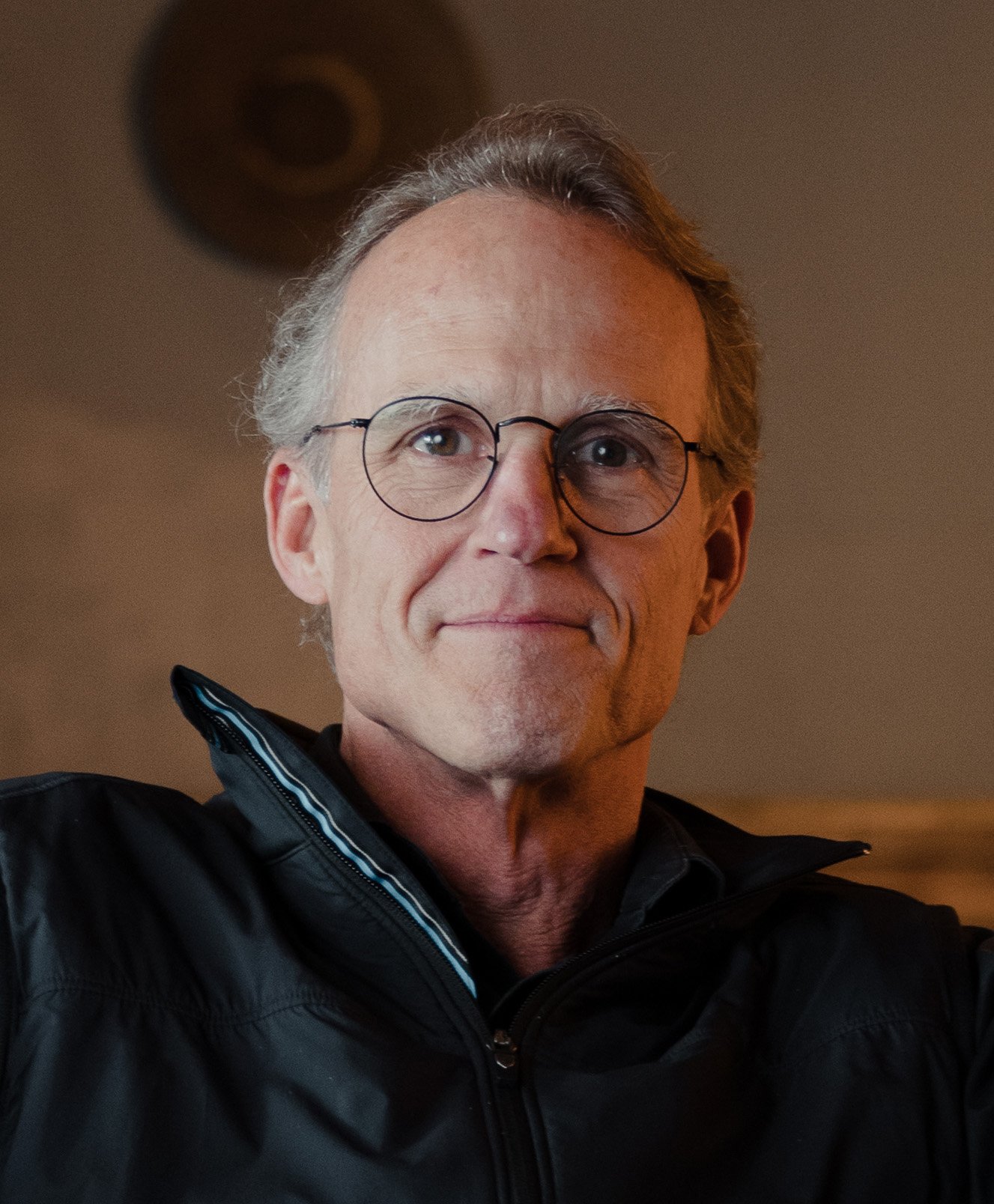What Is Business Vision: The Core of Strategy and Growth
If you’re an ambitious founder/CEO, you’re driven to build something bigger than yourself. Your vision is at the core of your business’s strategy and growth; it’s not just where you want to go, but who you want to be and how you plan to get from here to there. In the early company-building stages, you’re mainly focused on short-term goals (around 90 days out), like being up and running in the first quarter, covering expenses by the first year, hiring and collaborating with team members, and attracting Ideal Customers (or maybe just getting clear on who your Ideal Customer is). You’re focused on survival, so there’s little time for lofty aspirations. But as your team grows, continuing to pursue only those short-term goals will inevitably stifle growth and lead to a bad outcome.
At Ninety, we believe that to build a company you’ll love forever, you need to start by developing a compelling business vision that will help you attract and retain what is often referred to as the right people in the right seats (we call them Ideal Team Members). Without them, it's almost impossible to get to that future state.
While setting a clear and compelling vision dramatically reduces the degree of difficulty associated with advancing from one Stage to the next, the fact is elements of your vision are likely to evolve a lot early on and then less and less over time. That’s completely fine. The rest of this article is intended to help you not just understand why but have a sense of where you are in the associated journey.

The Stages of Organizational Development
At Ninety, most of our customers are small or midsize organizations navigating what we refer to as the first five Stages of Development associated with turning an idea into a business and then a business into a company that many people would gladly either buy from you or take over running for you. The first five stages are:
- Stage 1 | Survive — Stage 1 businesses are usually new, and things like structure and process are unnecessary luxuries. It’s all about proving product-market fit and keeping the lights on.
- Stage 2 | Sustain — Having found some initial success and a likely place in a market, a Stage 2 business prioritizes what works and reinforces its core features. It seeks to prove that the product-market fit is scalable.
- Stage 3 | Scale — A Stage 3 business has proven product-market fit and is implementing a more intentional approach to work that includes adding functional departments like Sales, Marketing, and Customer Service. The main focus is developing a clear path to long-term viability.
- Stage 4 | Succeed — Organized and mostly expert, Stage 4 companies tend to no longer rely on their founders to run any of their core departments. With experts in place, they’re able to emphasize growth, integration, and sustainability.
- Stage 5 | Steward — A Stage 5 company is excellent comprehensively, from its aligned people to its processes and data integration. A successful structure is in place, and the founder/CEO is free to completely focus on where the company needs to be in 5–10 years or preparing it for sale or hand-off to another highly qualified leader. Such attributes allow the company to build wisely for the future.
What Is a Business Vision?
A business vision is best defined as the unified, concise set of dreams, commitments, and goals held by a tightly knit group of people, like you and your Senior Leadership Team (SLT) members. At Ninety, the essential components of a well-developed vision are what we refer to as Focus Filters. Focus Filters help everyone in the company align around what really matters. They provide everyone in your organization with what could be thought of as a Northern Constellation that helps you collectively navigate the long journey associated with turning your vision into reality.
At Ninety, our Focus Filters are shared with every employee even before we hire them. They inform and guide not just everything we do but every decision we make.
"Our vision is only actionable if we share it. Without sharing, it’s just a figment of our imagination."
— Simon Sinek
At Ninety, we have nine Focus Filters: our industry and niche; Ideal Customer; Compelling Value Proposition; Core Values; Compelling Why; Compelling and Audacious Goals; and 3-year, 1-year, and 90-day goals.
To advance up the Stages of Development, you’ll first need to gain clarity around each of the Focus Filters associated with your vision. I’ve written a lot about vision on our blog and in the 90u Library. If you’re still creating your vision (or want to refine it further), we’ve created a Vision Builders Workbook to help you and your team with guided steps.
How Vision Defines Your Purpose
Part of building your vision is defining why you’re doing what you’re doing. That’s your Compelling Why, and it’s the reason your organization exists.
Whatever your vision may be, your purpose has to center on something greater than just “making money.” As I share almost weekly:
“You don’t make money because you want to make money,
you make money because someone values what you do.”
What motivates you and your leadership team? What motivates your team members? How do you collectively make life better? In short, why does your business/company matter?
Agree on a Compelling Why that describes the reason your organization exists (Purpose), the powerful emotions that influence you (Passion), and a future state so appealing that you're all willing to go the extra mile, when necessary, to work toward it (Just Cause).
I’d go so far as to suggest that your Compelling Why should be at the core of your organization’s vision. By that, I mean that every other Focus Filter needs to be completely congruent with what Simon Sinek called your “Why” in his well-known leadership book It Starts with Why and now calls your “Just Cause.”
A vision, sometimes referred to as a vision statement, does more than just narrow down your business and financial focus. It also:
- Shapes your company’s culture, from who you hire to how you motivate your team
- Preserves your focus and prevents you from getting distracted (that’s why we call them Focus Filters)
- Describes who you serve, how you serve, and why you do what you do
But building your vision is not a one-size-fits-all process, and you’re not expected to get every element of your vision exactly right on day one. To better understand where you should start and how you should approach building your vision, it's helpful to identify what Stage of Development your company finds itself in. Doing so will direct you and your SLT to the best starting point to help you grow and scale.
The Five Stages of Development and Your Vision
Through my decades of experience as a visionary, entrepreneur, investor, and executive coach, I’ve found that most small and midsize organizations move through five distinct Stages of Development as they transition from emerging businesses to established companies.
The five Stages of Development is a framework that helps you identify where your organization is now and where you want to go. Businesses typically move from the Survive Stage, where you and your small team are scurrying to stay afloat, to the Steward Stage, where your SLT and their team leaders know how to run operations on their own. When you’ve reached this final stage, you, the founder/CEO, can focus solely on where the company needs to be in 5–10 years (or pass it on).
Your vision will evolve just as your business does. Identifying your company’s Stage of Development is key to knowing where you are developmentally and what is likely to come next on your list of priorities.
Let’s understand how each stage differs and grows into the next, taking a special interest in not just the role of vision but how it likely evolves.
The Survive Stage: Ideation and Vision Formation
All founders/CEOs go through the Survive Stage. This is the start-up stage, and the founder/CEO often fulfills many different roles, even those in which they’re not a subject matter expert. You’re always on the go, facing risks and challenges such as losing money, lack of leverage, and hitting dead ends.
This stage presents both the opportunity and the need to test a handful of crucial elements of your business, most importantly product-market fit. Your focus is getting clearer and clearer on who your Ideal Customer is, what product and/or service you’re going to provide, and what your Compelling Value Proposition (CVP) will be.
The clearer you are on your Ideal Customer, product and/or service, and CVP, the easier it will be to start compounding the helpful information that attracts and retains customers who are eager to buy what you’re selling. Your main focus is learning by doing.
The Sustain Stage: Prove, Stabilize, and Endure
You know you’ve arrived at the Sustain Stage when you’ve established enough product-market fit to start to invest in hiring more people. Now, your focus changes. You’re not as busy putting out fires, so you can focus on consistently delivering your product and/or service and creating revenue streams. At this stage, you zero in on what works; reinforce core features; refine your CVP; and hire people to help you expand your customer base, especially your repeat customers.
In this stage, your vision will start to evolve, your organization will become more focused, and your and your team's confidence will start to build. Your team has a better handle on what they need to do daily, so you can devote more time to hiring the right people for the right seats, crafting methods and processes, moving beyond production, and planning the next 3–12 months.
As you transition to this stage, you’ll be hiring more people and your organization may get to the point where you’re no longer hiring every person. This is a great moment to stand back, look at those you have hired, talk about what you love about them and what bugs you, and think about developing an explicit set of Core Values. If this is where you are, we recommend working through the section in our Vision Builders Workbook that walks you through how we teach our clients to do this.
Final share: Be aware that most Stage 3 founders/CEOs are still spreading themselves and the business too thin, being reactive rather than proactive, piling on too many overlapping tasks, and hiring generalists who may not have a Seat or position as they push more deeply into Stage 3. It's hard for this not to happen, but letting good people go still feels bad.
The Scale Stage: Adapting and Growing
Once the work your organization does is intentional, your focus should switch to scalability. You have more people working on your product and/or service, and these newer hires are more focused on their area of expertise, adding value to your organization. This stage allows you to add a deeper layer of expertise to your business while creating scalable processes and systems. Adhering to your business vision will crystallize a clear path to long-term viability.
As you scale, the following areas may become challenging: focusing on getting smart stuff done; moving from paying the bills to producing actual profits; creating a clear and scalable structure and the associated processes; and producing profits efficiently, effectively, and consistently. By creating a plan to tackle these scaling challenges, you’ll be well on your way to the next Stage of Development.
At this point, your vision should be pretty solid in terms of the definitions of your: niche, Ideal Customer, CVP, and Core Values. It’s also wise to start setting at least 90-day goals (aka Rocks) and 1-year goals. I’d also love you to have your Compelling Why and your Compelling and Audacious Goals nailed, but they’re not essential at this stage.
The Succeed Stage: Moving Beyond the Founder
In this exciting stage, you’ve proved product-market fit and either demonstrated profitability or the ability to generate such if and when required. At this stage, you should have a pretty decent vision built out. If it's compelling, it will enable you to attract and retain a great second-in-command (what EOS® refers to as an Integrator™), or a tight C-Suite, as well as strong department heads and team leaders who not only share your vision but are ready, willing, and able to turn it into reality.
You are now in a position where you can confidently emphasize growth and sustainability. Now that your vision is owned by your SLT, you can work on entrenching it throughout the organization. As long as you continue to grow and hire, this work is never done.
If you haven't already, this is your time to focus on integration and adding 1- and 2-year departmental goals to your vision. This stage does present additional risks and challenges, however, including organizational “tug of wars,” conflict or silos between departments, and attracting and retaining expert leaders who are great culture carriers.
The Steward Stage: Legacy and Vision Perseverance
You’ve made it! You’ve built a company that others can capably run without your week-to-week or even month-to-month involvement. The business vision you’ve worked hard to build, instill, and incorporate is the cornerstone for all you’ve achieved and all that’s to come. It’s an inseparable part of your product and/or service and mode of operation that’s fully embedded in the company’s culture.
Now, you can focus on the next 5–10 years: on longer-term planning, sustaining your aspirations, being your company’s cultural carrier, and driving your company’s Just Cause. You can confidently step back from the 90-day and 1-year goals and make room for other longer-term ambitions.
Note that even at this stage, you and your organization will continue to face hurdles (you know this to be true, but I couldn’t help myself). The truth is that your company is now a complex adaptive system. And like all complex adaptive systems, you can’t escape the second law of thermodynamics. In short, every Stage 5 organization is subject to lots of entropy. Unfortunately, entropy is everywhere. It's in your structure, it's in your processes, it's in your products and/or services, it's in your KPIs and the associated targets that help you know when things are good or not so good, and, at the risk of stating the obvious, it's in your people.
But those issues can now be confidently handled by your SLT. Your job as founder/CEO is to lead. It's to have a compelling vision for the next 5-10 years. It’s to help your leaders attract and retain amazing talent. It's to find great partners, and it’s to do the hard work of developing new lines of revenue such as expanding the products and/or services you provide your Ideal Customers and/or expanding the very definition of your geographic reach.
In my opinion, way too many founders/CEOs exit stage right way too early. My hope for you is you build a company you’ll not only love forever but one you want to run for a very long time.

How Ninety Empowers Your Business Vision
It’s my hope that this article has provided you with not just a sense of your business’s Stage of Development but how you and your vision should evolve. Whatever stage you find yourself in, the question you may be asking yourself is, “How do I/we move forward?”
At Ninety, we know that it’s tough to translate theories and concepts into visible or actionable items. It’s not enough to know in your head where you are and where you’re going. Eventually, you need a clear and compelling vision. Eventually, you need to agree on a vision with your SLT. Eventually, you and your SLT need to not only share it with everyone in your organization but enroll them in it. That’s why we created the Vision tool.
We built the Vision tool to help you progress, succeed, and advance through the five Stages of Development. It gives you the platform and framework to make your vision visible, shareable, and inspiring.
But our job at Ninety is to do more than just provide you with a useful tool. We’re here to ensure your success every step of the way — and not just through the vision-building process. We strive to give you everything you need (except capital, sorry) to build a company you will not only love forever but, even better, a company full of people who love it, too. We’ve built a complete library of resources for you to consult and learn from at your own pace.
Try Ninety to see the ways our platform, built for leaders of small and midsize companies, can help propel your organization to success. It all starts with the Vision tool.


![Featured_Workbook_Download [Vision Builders]-02 (1)](https://www.ninety.io/hs-fs/hubfs/Featured_Workbook_Download%20%5BVision%20Builders%5D-02%20(1).png?width=800&height=289&name=Featured_Workbook_Download%20%5BVision%20Builders%5D-02%20(1).png)





